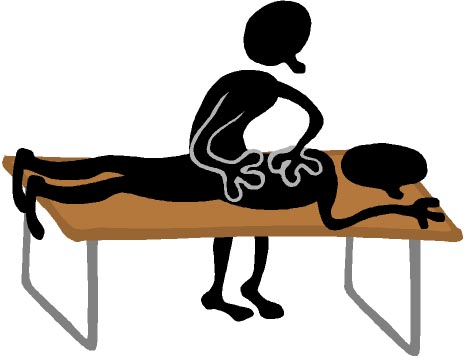THE 10-R TECHNIQUE
The prosocial response formation
technique, often referred to as the "10-R" technique was developed by Patrick Sloss to assist in the control and change
of aggressive or non-compliant behavior. It is promoted as an alternative
to traditional approaches of punishing disruptive behavior.
The approach, which is best suited to students in Kindergarten
to grade 4 (or students with mental retardation at
developmental ages up to 8 or 9 years of age) recommends the implementation
of a sequence of ten steps to be followed whenever a student's misbehavior
is unreceptive to warnings and mild interventions. The 10-R technique
involves the student in the correction of inappropriate behavior by having
him/her analyze why it was wrong or non-productive, and requiring the practice
of proper actions.
How to Use the 10-R Technique
For maximum effectiveness, it is recommended that
all ten steps be followed consistently after each behavioral incident.
1. Response cost (penalty).
When a non-acceptable action is displayed, remove a pre-determined amount
of reinforcer (e.g., free time, points) as the student
states which rules were broken. The amount to be lost is known to all students
because of your discussions with them.
2.  Relaxation. Have the student go to a preassigned place (e.g.,
a mat, carrel, or corner) and relax himself/herself. S/he
summons you when calm. If the voice is excited or sarcastic in tone,
or if the muscles appear tense (You may want to lightly shake
his arm or leg to monitor muscle tension. The arm should "wobble".)
tell him/her to continue to attempt to become calm and relaxed.
Relaxation. Have the student go to a preassigned place (e.g.,
a mat, carrel, or corner) and relax himself/herself. S/he
summons you when calm. If the voice is excited or sarcastic in tone,
or if the muscles appear tense (You may want to lightly shake
his arm or leg to monitor muscle tension. The arm should "wobble".)
tell him/her to continue to attempt to become calm and relaxed.
3. Rectify. Have
the student provide resitution for any physical/emotional damage done.
This may involve repair of items, an apology to another, or repayment for
damage.
4. Recognize.
Help the student to recognize the cause of his misbehavior and identify
more appropriate responses for that situation (The classroom
counseling link on the home page may be useful here).
5. Rehearsal.
Have the student practice the alternative behavior(s) identified in Step 4. The roleplaying situation should be similar
to the event which was handled inappropriately by the student.
6. Reinforce.
Reinforce, praise or otherwise reward the student for having demonstrated
appropriate behavior. Encourage more of the behavior in the future.
Also reinforce the behavior when it is later displayed by the student.
7. Reflect.
Ask the student to identify the consequences of his disruptive behavior
and compare them with the possible consequences of the desired action.
This analysis helps the student to see the benefits of proper behavior.
8. Re-enter.
The student has missed anywhere from a few minutes to a few hours during
this session. S/he should finish all work missed, or be returned
to the least pleasant activity that was missed. This action ensures
that these sessions do not become a learned way to avoid certain schoolwork.
9. Record.
Record data to assist in evaluating the long term effectiveness of this
intervention. 
10. Repeat. Use
this technique as necessary to change behavior.
Activities and Discussion
Questions
1. You are leading
Kristen through the ten steps. She refuses to apologize to Shirley
for having hit her. Kristen becomes angry again. What can be done?
2. Dan refuses to go
to the relaxation mat as directed. What can you do?
3. How could these ten
steps be revised or condensed if the student (or the teacher)
can't remember all-ten?
4. How could two simultaneously
misbehaving students be handled at one time by a teacher using this technique?
5. What information
do you want to record in Step #9 of the 10-R technique?
6. What might be done
if your recording indicates that this technique has not been effective
in changing a student's behavior.
7. With a partner, role
play the use of the 10-R approach. Have your partner imitate
a student who is of concern to you.
8. Do you think someone was
trying a little bit too hard to devise 10 steps that all start with an
"R"?
For More Information
Schloss, P. J. (1983). The prosocial response formation technique. The
Elementary School Journal, volume 83, issue 3, pages 220-229.

 Relaxation. Have the student go to a preassigned place (e.g.,
a mat, carrel, or corner) and relax himself/herself. S/he
summons you when calm. If the voice is excited or sarcastic in tone,
or if the muscles appear tense (You may want to lightly shake
his arm or leg to monitor muscle tension. The arm should "wobble".)
tell him/her to continue to attempt to become calm and relaxed.
Relaxation. Have the student go to a preassigned place (e.g.,
a mat, carrel, or corner) and relax himself/herself. S/he
summons you when calm. If the voice is excited or sarcastic in tone,
or if the muscles appear tense (You may want to lightly shake
his arm or leg to monitor muscle tension. The arm should "wobble".)
tell him/her to continue to attempt to become calm and relaxed.
